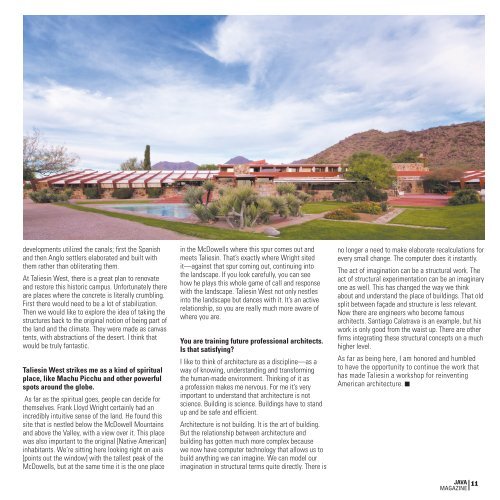Java.Mar.2016
You also want an ePaper? Increase the reach of your titles
YUMPU automatically turns print PDFs into web optimized ePapers that Google loves.
developments utilized the canals; first the Spanish<br />
and then Anglo settlers elaborated and built with<br />
them rather than obliterating them.<br />
At Taliesin West, there is a great plan to renovate<br />
and restore this historic campus. Unfortunately there<br />
are places where the concrete is literally crumbling.<br />
First there would need to be a lot of stabilization.<br />
Then we would like to explore the idea of taking the<br />
structures back to the original notion of being part of<br />
the land and the climate. They were made as canvas<br />
tents, with abstractions of the desert. I think that<br />
would be truly fantastic.<br />
Taliesin West strikes me as a kind of spiritual<br />
place, like Machu Picchu and other powerful<br />
spots around the globe.<br />
As far as the spiritual goes, people can decide for<br />
themselves. Frank Lloyd Wright certainly had an<br />
incredibly intuitive sense of the land. He found this<br />
site that is nestled below the McDowell Mountains<br />
and above the Valley, with a view over it. This place<br />
was also important to the original [Native American]<br />
inhabitants. We’re sitting here looking right on axis<br />
[points out the window] with the tallest peak of the<br />
McDowells, but at the same time it is the one place<br />
in the McDowells where this spur comes out and<br />
meets Taliesin. That’s exactly where Wright sited<br />
it—against that spur coming out, continuing into<br />
the landscape. If you look carefully, you can see<br />
how he plays this whole game of call and response<br />
with the landscape. Taliesin West not only nestles<br />
into the landscape but dances with it. It’s an active<br />
relationship, so you are really much more aware of<br />
where you are.<br />
You are training future professional architects.<br />
Is that satisfying?<br />
I like to think of architecture as a discipline—as a<br />
way of knowing, understanding and transforming<br />
the human-made environment. Thinking of it as<br />
a profession makes me nervous. For me it’s very<br />
important to understand that architecture is not<br />
science. Building is science. Buildings have to stand<br />
up and be safe and efficient.<br />
Architecture is not building. It is the art of building.<br />
But the relationship between architecture and<br />
building has gotten much more complex because<br />
we now have computer technology that allows us to<br />
build anything we can imagine. We can model our<br />
imagination in structural terms quite directly. There is<br />
no longer a need to make elaborate recalculations for<br />
every small change. The computer does it instantly.<br />
The act of imagination can be a structural work. The<br />
act of structural experimentation can be an imaginary<br />
one as well. This has changed the way we think<br />
about and understand the place of buildings. That old<br />
split between façade and structure is less relevant.<br />
Now there are engineers who become famous<br />
architects. Santiago Calatrava is an example, but his<br />
work is only good from the waist up. There are other<br />
firms integrating these structural concepts on a much<br />
higher level.<br />
As far as being here, I am honored and humbled<br />
to have the opportunity to continue the work that<br />
has made Taliesin a workshop for reinventing<br />
American architecture.<br />
JAVA 11<br />
MAGAZINE


















